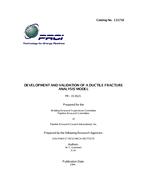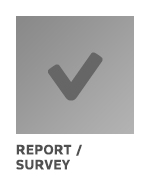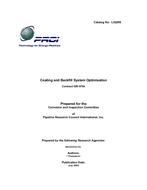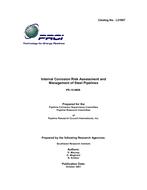Provide PDF Format
PRCI PR-15-9121
- Development and Validation of a Ductile Fracture Analysis Model
- Report / Survey by Pipeline Research Council International, 05/01/1994
- Publisher: PRCI
$198.00$395.00
L51718e
Southwest Research Institute
Need: In close cooperation with the Centro Sviluppo Materiali (CSM) and SNAM of Italy, with several years of support from the PRCI NG-18 committee, the Southwest Research Institute (SwRI) has developed and validated a "first principles" predictive model for ductile fracture in a gas transmission pipeline. In particular, the coordinated SwRI and CSM projects for the PRC -supplemented by work contributed by SNAM - has established a theoretically valid methodology and an accompanying line pipe material characterization procedure for gas industry use. This progress provides a theoretically sound framework for designing and operating gas transmission pipelines to be without risk of a large-scale ductile fracture event. However, there remained two important aspects of this technology that needed to be addressed before practical use of the methodology could be made by gas transmission companies. First, because the preceding projects concentrated on pipes with natural gas, to cover the full range of gas transmission pipeline service, the approach needed to be extended to include the effects of gases rich in hydrocarbons. Second, as the number of full-scale pipe fracture experiments that were included in the developmental phase of the research were limited, other data for validation of the model needed to be identified and employed. These two aspects of the ductile fracture methodology development process were conducted concurrently, and have now been completed. The progress that has been provided in detail in this report. The work is culminated by a relation through which the methodology can be applied by pipeline engineers to assess the possibility of a ductile fracture propagation.
Benefit: This report describes the development of a predictive model for ductile fracture in a gas transmission pipeline, thus providing a theoretically sound framework for designing and operating gas pipelines to be without risk of a large-scale ductile fracture event. The model represents an improvement on a number of empirical relations used in designing natural gas pipelines in that this model has been generalized to consider a wide-range of hydrocarbon contents and validated through both additional full-scale instrumented tests carried out by Centro Sviluppo Materiali of Italy and computer simulations conducted at Southwest Research Institute. Application of the model in pipeline design is based on determination of the maximum driving force for fracture, as described in the report, and contrasting this value with measured material resistance that provides a basis for assessing the likelihood of ductile fracture occurring. For existing pipelines the procedure can be used to obtain the maximum operating line pressure that will not put the pipeline at risk of ductile fracture.
Result: The development and validation work described in this paper has produced relations and procedures for the practical use of the results by gas transmission pipeline engineers. Further research that would broaden the applicability of the model and make it more immediately usable by the industry are provided in the appendix of this document.
Southwest Research Institute
Need: In close cooperation with the Centro Sviluppo Materiali (CSM) and SNAM of Italy, with several years of support from the PRCI NG-18 committee, the Southwest Research Institute (SwRI) has developed and validated a "first principles" predictive model for ductile fracture in a gas transmission pipeline. In particular, the coordinated SwRI and CSM projects for the PRC -supplemented by work contributed by SNAM - has established a theoretically valid methodology and an accompanying line pipe material characterization procedure for gas industry use. This progress provides a theoretically sound framework for designing and operating gas transmission pipelines to be without risk of a large-scale ductile fracture event. However, there remained two important aspects of this technology that needed to be addressed before practical use of the methodology could be made by gas transmission companies. First, because the preceding projects concentrated on pipes with natural gas, to cover the full range of gas transmission pipeline service, the approach needed to be extended to include the effects of gases rich in hydrocarbons. Second, as the number of full-scale pipe fracture experiments that were included in the developmental phase of the research were limited, other data for validation of the model needed to be identified and employed. These two aspects of the ductile fracture methodology development process were conducted concurrently, and have now been completed. The progress that has been provided in detail in this report. The work is culminated by a relation through which the methodology can be applied by pipeline engineers to assess the possibility of a ductile fracture propagation.
Benefit: This report describes the development of a predictive model for ductile fracture in a gas transmission pipeline, thus providing a theoretically sound framework for designing and operating gas pipelines to be without risk of a large-scale ductile fracture event. The model represents an improvement on a number of empirical relations used in designing natural gas pipelines in that this model has been generalized to consider a wide-range of hydrocarbon contents and validated through both additional full-scale instrumented tests carried out by Centro Sviluppo Materiali of Italy and computer simulations conducted at Southwest Research Institute. Application of the model in pipeline design is based on determination of the maximum driving force for fracture, as described in the report, and contrasting this value with measured material resistance that provides a basis for assessing the likelihood of ductile fracture occurring. For existing pipelines the procedure can be used to obtain the maximum operating line pressure that will not put the pipeline at risk of ductile fracture.
Result: The development and validation work described in this paper has produced relations and procedures for the practical use of the results by gas transmission pipeline engineers. Further research that would broaden the applicability of the model and make it more immediately usable by the industry are provided in the appendix of this document.
Related Products
PRCI PR-138-9724
Gas Transmission Industry Experience Of Turbine Parametric Emission Monitoring Systems (PEMS)..
$6.00 $12.00
PRCI PR-15-9808
Internal Corrosion Risk Assessment & Management of Steel Pipelines..
$448.00 $895.00




